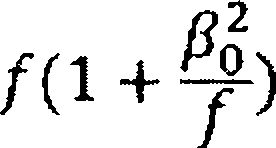University of Delhi 2010-2nd Year M.Tech Information Technology 1st nd accelerator physics & technology UNIVERSITY - Question Paper
Yoiu Roll No
This question paper contains 3 printed pages 7016
M.Tech /II Seni.
NUCLEAR SCIENCE & TECHNOLOGY Paper :NST - 607 : Accelerator Physics & Technology J
Time 3 hours Maximum Marks 70
(Write your Roll No on the top immediately on icceipt of this question paper) Attempt any thiee from the remaining tour questions each one ot which caincs 18 maiks
I (a) Highlighting important aspects of a microtron, obtain an expression for the energy gam per revolution by an electron Obtain its value for a microtron with magnetic field = ITesla, RF frequency = 3 GHz (1 G = 109), and difference in the time periods between successive revolutions being equal to the time period of the RF voltage 4
(b) Consider a RF cavity for the DORIS ring at the DESY Laboratory, Germany The inner diameter of the cavity measures 462 mm and length of the cavity is 276 mm, what would be the resonant frequency and wavelength for this cavity in TM010 mode and TM0n mode(first non-zero root of zeroth order Bessel function is at 2 405} 4
(c) Starting from the conservation of energy in a Constant-Gradient RF cavity under steady-state condition, obtain expressions for the group velocity and filling time m terms of shunt impedance, quality factor, attenuation constant, input power, and length of the cavity (assuming negligible beam loading) 4
* (d) Consider a linear electron accelerator with energy gam per meter ~ 30 MeV/m Find the radiated synchrotron power, and ratio of the radiated power to the power delivered by accelerator, assuming relativistic velocities 4
2 CERN's Large Hadron Collider (LHC) is designed to accelerate protons to kinetic energy of 7000
GeV (1 GeV = 109 eV)
a ) What is the relativists p? What is their magnetic rigidity in T-m? b ) There are 1232 dipole magnets, each of length 14 3 m bending in normal configuration What is the corresponding dipole magnetic field? Note that the bending angle provided by each dipole magnet is 2ti/1232
d ) Given that the total machine circumference is 26658 9 m, what is the revolution frequency? The total energy gam per revolution is 8 MeV How long (in s) does it take to accelerate protons from 450 GeV to 7000 GeV?
e ) The RF frequency is reported to be 400 8 MHz What is the harmonic number(give nearest integer)?
3
2
f) What is the energy loss per revolution per proton from radiation in the bend dipole?
4
g ) Given that the momentum compaction factor is 3 47x10 4, what is the transition energy? What is the slip factor at the injection energy of 450 GeV?
2
To increase the event rate in colliders one would need to have a very small beam size at the collision point which necessitates "low beta" insertion in an accelerator A simplified model of such an insertion is a strong focusing lens of focal length f (assuming thin lens approximation for quadrupole of negligible length) immediately followed by a drift of length s Suppose s=0 corresponds to the location of the starting point of the focusing lens, and assume beta function (s=0)=p0 is given and the phase-space ellipse is upright
a What would be oc(s=0) and y(s=0}? 1 b What is the 2x2 transfer matrix, M, to a location of distance 's; downstream of the
focusing lens Note that thin focusing lens is followed by a drift 3
c What are the transpose and inverse of the transfer matrix? 1 d Starting from the 2x2 beta-matnx at s=0 location (B0), show that the beta-matnx at
distance 's' can be written as B(s) = MB0MT 3 e Usmg (d), find out the beta function, p(s), at the distance s' downstream of the focusing
lens m terms of s, f and p0 Also find out the expression of a(s) 4
f Show that p{s) is extremum at the location 2
PS

g Is it a maximum or minimum? What is P(sextremum) at the location of the extremum? 2 h What is a(sextremuTi) at the location of the extremum? 2
(a) Assuming that there is no energy loss by synchrotron radiation, derive a formula for phase-energy {or synchrotron) oscillations for a beam of particles travelling in longitudinal direction 6
(b) For large amplitudes of oscillations, deduce an expression for the potential energy Show that the maximum phase deviation for a stable solution is ti - 2\yo, where v|/0 is the synchronous phase 4
(c) Usmg phase energy diagrams, explain the concept of rf-bucket 3
(d) Why synchronous phase (\\>o) of 0 or 90 cannot be used for beam acceleration"? 1
(e) Deduce an expression of maximum energy deviation (or energy acceptance) for a stably circulating particle 4
5 (a) Find expressions of electric and magnetic field for a cylindrical waveguide with circular cross-section of radius 'a' in Transverse Magnetic (TM) mode Find out the phase and group velocity, and also an expression of cut-off frequency 8
(b) Can such a waveguide be used for particle acceleration? 2
(c) Using appropriate boundary conditions along longitudinal direction, deduce expressions of electric and magnetic field for a cylindrical cavity of length I, and hence obtain an expression of resonant frequency 4
(d) Usmg Brilloum diagrams, describe qualitatively how a multi cell cylindrical cavity can be used for particle acceleration 4
Page 3 of 3
|
Attachment: |
| Earning: Approval pending. |
